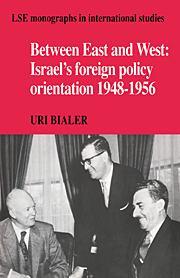Book contents
- Frontmatter
- Contents
- Acknowledgments
- INTRODUCTION
- Part I THE INTERNAL DIMENSION
- Part II RED STAR OVER ZION
- Part III THE WESTERN CONNECTION
- 9 THE MILITARY AND ECONOMIC DIMENSIONS
- 10 FROM NEUTRALITY TO THE SEARCH FOR A LINK
- 11 SOLIDIFICATION OF A WESTERN ORIENTATION
- 12 FAILURE OF “FACTS AND PACTS” POLICY
- EPILOGUE: “A people that dwells alone”?
- Appendix 1 U.N. voting record
- Appendix 2 Biographical notes
- Appendix 3 Israel's votes at the U.N.
- Index
- LSE MONOGRAPHS IN INTERNATIONAL STUDIES
10 - FROM NEUTRALITY TO THE SEARCH FOR A LINK
Published online by Cambridge University Press: 24 November 2009
- Frontmatter
- Contents
- Acknowledgments
- INTRODUCTION
- Part I THE INTERNAL DIMENSION
- Part II RED STAR OVER ZION
- Part III THE WESTERN CONNECTION
- 9 THE MILITARY AND ECONOMIC DIMENSIONS
- 10 FROM NEUTRALITY TO THE SEARCH FOR A LINK
- 11 SOLIDIFICATION OF A WESTERN ORIENTATION
- 12 FAILURE OF “FACTS AND PACTS” POLICY
- EPILOGUE: “A people that dwells alone”?
- Appendix 1 U.N. voting record
- Appendix 2 Biographical notes
- Appendix 3 Israel's votes at the U.N.
- Index
- LSE MONOGRAPHS IN INTERNATIONAL STUDIES
Summary
Evidence recently made available in Israel reveals that the possibility of a change in Israel's foreign policy orientation was not discussed at an administrative-political level until the end of 1949. Before then, Israel's basic policy had never been debated at any senior forum. “Non-identification,” as it was sometimes termed, had been accepted as a fundamental – and publicly declared – fact of Israeli life. There existed a number of clear reasons why this should have been so. One was Israel's sense of responsibility for the fate and welfare of the entire Jewish people, which was dispersed throughout both major international blocs. Secondly, neither could Israelis ignore the historic fact that their state had been established with the agreement and support of both the superpowers. Israel owed them a certain debt of gratitude and was interested in maintaining good relations with both in order to surmount the difficulties involved in the defense of her independence. The third motive was a sincere concern for peace in the world and the wish to refrain from encouraging inter-power rivalry or intensifying it by identifying with one side or the other.
Equally compelling, although accorded very little publicity at the time, were domestic considerations. Specifically, the desire to keep peace within the ranks of the labor movement in Israel, constituted a fourth reason for Israel's “non-identification.” At a time when the political affiliations of numerous new immigrants was still undefined, this consideration was particularly weighty. Indeed, the entire fabric of the Labor Party's culture seemed to be threatened by the possibility of extremist attacks from both left and right.
- Type
- Chapter
- Information
- Between East and WestIsrael's Foreign Policy Orientation 1948–1956, pp. 206 - 234Publisher: Cambridge University PressPrint publication year: 1990



